Unit 6 Do you like bananas Section A 2d-3c课件+音频(共34张PPT) 人教版英语七年级上册
文档属性
| 名称 | Unit 6 Do you like bananas Section A 2d-3c课件+音频(共34张PPT) 人教版英语七年级上册 |

|
|
| 格式 | pptx | ||
| 文件大小 | 2.3MB | ||
| 资源类型 | 教案 | ||
| 版本资源 | 人教新目标(Go for it)版 | ||
| 科目 | 英语 | ||
| 更新时间 | 2023-11-18 13:13:25 | ||
图片预览


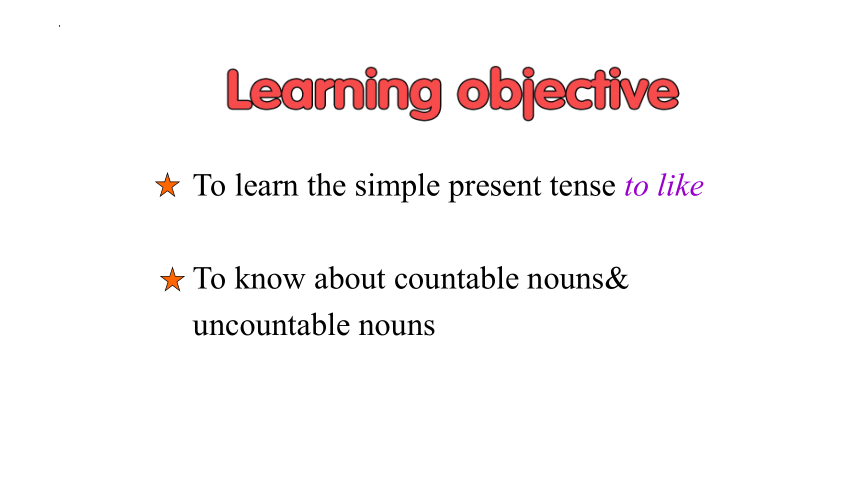
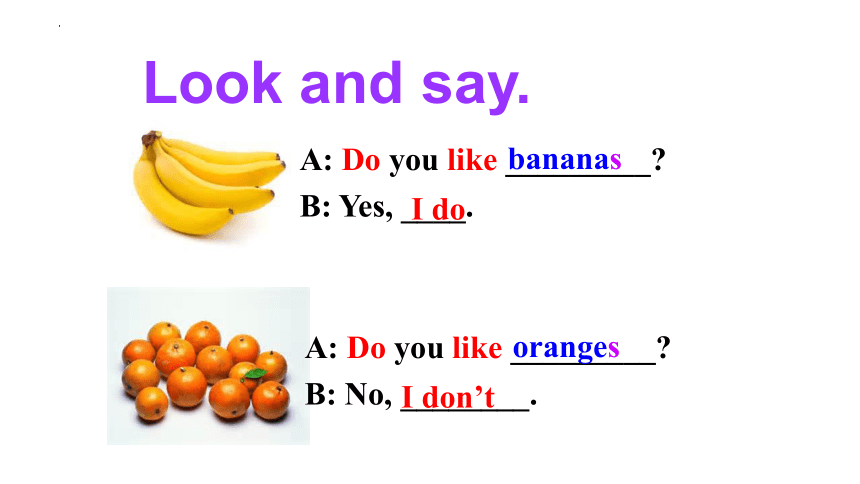

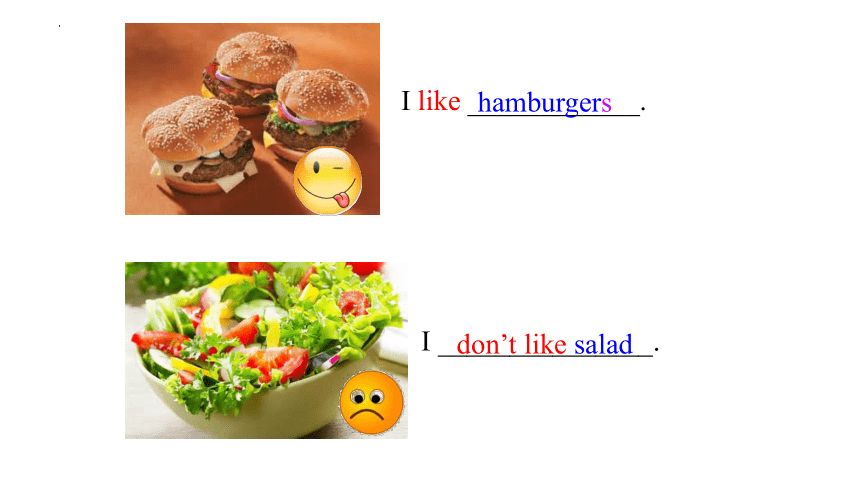
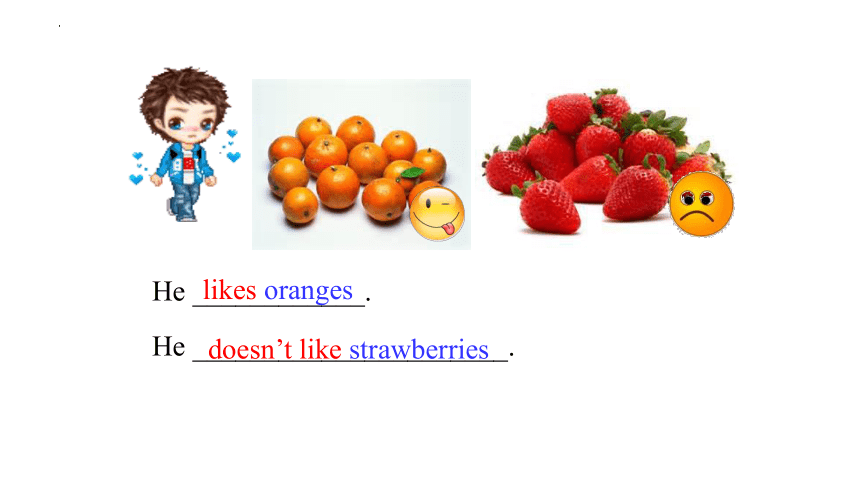


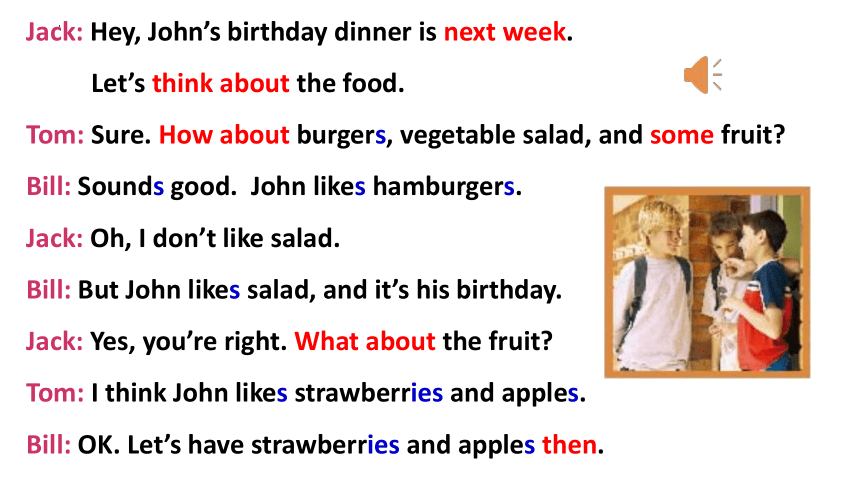
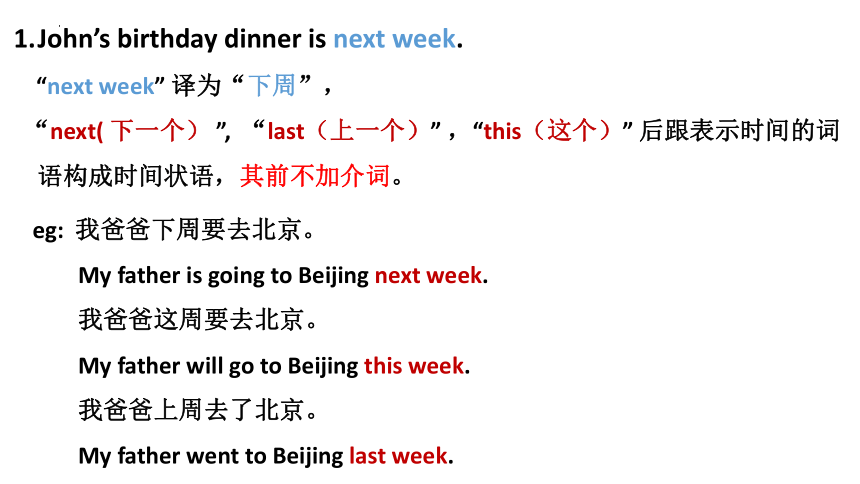
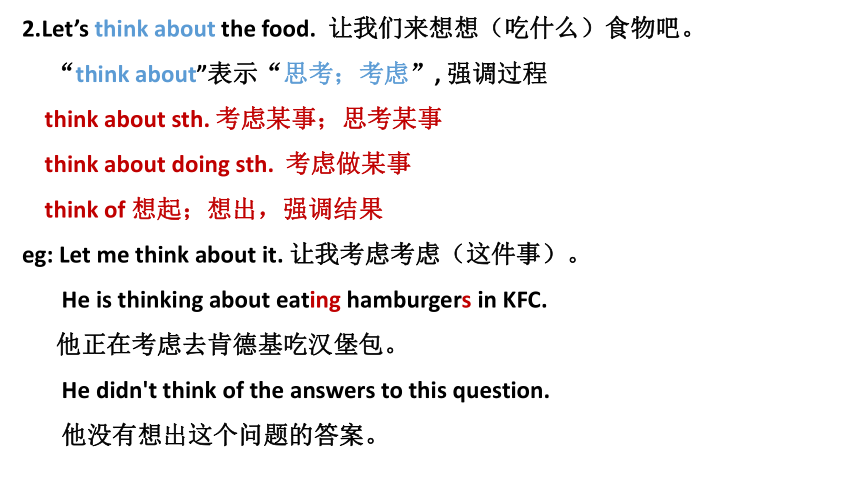
文档简介
(共34张PPT)
Unit6 Do you like bananas?
Unit 6
Do you like bananas
Section A 2d-3c
To learn the simple present tense to like
To know about countable nouns& uncountable nouns
A: Do you like _________
B: Yes, ____.
Look and say.
A: Do you like _________
B: No, ________.
I don’t
bananas
oranges
I do
A: ___ you ____ ___________
B: No, ________.
I don’t
Do
like
strawberries
A: ___ they ____ ______
B: No, __________.
they don’t
Do
like
pears
I like ____________.
I _______________.
hamburgers
don’t like salad
He ____________.
He ______________________.
likes oranges
doesn’t like strawberries
She _________________.
She __________________.
likes hamburgers
doesn’t like pears
Listen and fill in the blanks. When is John’s birthday dinner
1.______________.
What food does John like
2.___________
3.__________.
What fruit does John like 4.____________.
5.___________.
Next week
Hamburgers.
Salad
Strawberries
Apples
Jack: Hey, John’s birthday dinner is next week.
Let’s think about the food.
Tom: Sure. How about burgers, vegetable salad, and some fruit
Bill: Sounds good. John likes hamburgers.
Jack: Oh, I don’t like salad.
Bill: But John likes salad, and it’s his birthday.
Jack: Yes, you’re right. What about the fruit
Tom: I think John likes strawberries and apples.
Bill: OK. Let’s have strawberries and apples then.
John’s birthday dinner is next week.
“next week” 译为“下周”,
“next( 下一个) ”, “last(上一个)” ,“this(这个)” 后跟表示时间的词语构成时间状语,其前不加介词。
eg: 我爸爸下周要去北京。
My father is going to Beijing next week.
我爸爸这周要去北京。
My father will go to Beijing this week.
我爸爸上周去了北京。
My father went to Beijing last week.
2.Let’s think about the food. 让我们来想想(吃什么)食物吧。
“think about”表示“思考;考虑”, 强调过程
think about sth. 考虑某事;思考某事
think about doing sth. 考虑做某事
think of 想起;想出,强调结果
eg: Let me think about it. 让我考虑考虑(这件事)。
He is thinking about eating hamburgers in KFC.
他正在考虑去肯德基吃汉堡包。
He didn't think of the answers to this question.
他没有想出这个问题的答案。
3. What about the fruit
What/ How about sth./ doing sth. ......怎么样?
其他常见的表示建议的句型:
① Let's do... 让我们做......
eg. What/How about some milk 来些牛奶怎么样?
What/ How about drinking some milk?喝一些牛奶怎么样?
在表示建议或征求对方意见的句子中,some 不能改为any。
4. Let’s have strawberries and apples then.那就让我们吃些草莓和苹果吧
have 吃;喝 eat 吃 drink 喝 take 吃;服:take the medicine
1)在英语中“have”+三餐,意为 “吃...餐”
have breakfast
have rich lunch
have fast dinner
2)have+表示食品、饮料等的名词,意为“吃;喝”
have (some) bread 吃面包
have eggs (for breakfast) (早餐)吃鸡蛋
have (a cup of )tea 喝(一杯)茶
What do you want to have for lunch
你午餐想吃什么?
/
a
a
表示三餐的名词(breakfast, lunch, supper, dinner)前不加冠词,但是前有修饰词时可加冠词。
Grammar Focus
请仔细观察下列单词。
可数名词和不可数名词
可数名词
(1)
(2)
(3)
(4)
定义:是可以计数的名词。
可数名词前可以用a, an修饰限定,表“一个……”。
可数名词前可以用one, two, three ……等词限定。
可数名词有复数形式。
可数名词复数形式的构成 1
名词特点 词尾加法 词尾读音方法 例词
一般情 况下
加-s
1. -s在清辅音后读[s]
2. -s在浊辅音后读[z]
3. -s在元音后读[z]
4. 以音素
结尾的,读[iz]
desks
apples
pears
以-s, -x, -sh, -ch 结尾的
classes
dishes
加-es
oranges
可数名词复数形式的构成 2
名词特点 词尾加法 词尾读音方法 例词
改y为i 再加-es
-ies读[iz]
families
dictionaries
以元音字母加y结尾的
加-s
-s读[z]
boys
keys
以辅音字母加y结尾的
以“f或fe”结尾的
变f或fe为v,再加-es
-ves读[vz]
knives
名词特点 词尾加法 词尾读音方法 例词
以o结尾的
有生命的事物加-es
-es读[z]
tomatoes
potatoes
无生命的事物加-s
-s读[z]
photos
radios
不可数名词
(1)
(2)
(3)
定义:是指不能计数的名词。
不可数名词前不可以用a, an限定。
不可数名词没有复数形式, 要表示数量的多少时,其前可以加some, any或表数量的词语。
milk
tea
meat
water
uncountable nouns
bread
rice
定义:在某些情况下能计数,在某些情况下
不能计数的名词。
e.g. (1) a chicken 一只鸡
chicken 鸡肉
(2) an ice-cream 一个冰淇淋
ice-cream 冰淇淋(指成份)
(3) a salad 一碟沙拉
salad 沙拉(指成份)
countable and uncountable nouns
Countable nouns Uncount-able nouns Countable and uncountable nouns
hamburgers, ___ ___________________________________________________________________________
apples
bananas
pears
carrots
tomatoes
vegetables
strawberries
eggs
oranges
milk
bread
rice
food
fruit
ice-cream
salad
chicken
将之前所学的名词进行分类。
可数名词与不可数名词在一定条件下可以转化。
很多表示蔬菜、动物等的名词, 一般来说是可数的,
但是表示餐桌上的食品时, 就转换为不可数名词。
(1)a chicken 一只鸡(活的)
chicken 鸡肉(烹饪的)
(2)an ice-cream 一个冰淇淋
ice-cream 冰淇淋(指成份)
(3)a salad 一碟沙拉
salad 沙拉(指成份)
既可数又不可数名词
一、用所给单词的适当形式填空。
1.I like (banana).
2.Do you like those (thing)?
3.He eats (chicken) for lunch.
4.Does your sister like (salad)
5.My sister eats two (tomato) every day.
6.There are two (man) in the room.
7.Some new (watch) are on the table.
8.He likes all (vegetable).
强化训练
bananas
things
chicken
salad
tomatoes
men
watches
vegetables
二、把下列句子由单数形式变为复数形式或由复数形式变成单数形式。
A.把单数形式句子,转变为复数形式句子
1.This is her brother.
.
2.She watches TV every day.
.
3.That sports star eats lots of vegetables.
.
B.把复数形式句子,转变为单数形式句子
4.We have lots of tomatoes every day.
.
5.The radio tapes are in their desks.
.
强化训练
These are their brothers.
They watch TV every day.
Those sports stars eat lots of vegetables.
I have a tomato every day.
The radio tape is in his/her desk.
1. I like fruit, but I ( don't/doesn't) like vegetables.
2. She (like/likes) bread, but she (doesn't/don't) like salad.
3. He (like/likes ) bananas, but he (don't/doesn't) like oranges.
4. We (likes/like) hamburgers, but we don't (like/likes) chicken.
5. They (likes/like) pears, but they(don't/doesn't) like strawberries.
Underline the correct words in the brackets.
3a
So, let's get salad. Yes, I do.
Do you like salad OK.
3
2
1
4
Number these sentences [1-4] to make a conversation.
3b
思维迁移
根据句意和汉语提示写单词。
My sister eats an ___ (鸡蛋) every
morning.
2. My mother likes eating ______ (苹果).
3. We have some __________(蔬菜) every day.
4. Do you like eating ________(鸡肉)
5. Let’s have some _____ (食物).
egg
apples
vegetables
chicken
food
III. 按要求写出下列单词的正确形式。
1. watch(复数)____________
2. carrot(复数)____________
3. sound(第三人称单数)____________
4. tomato(复数)____________
5. I(宾格)____________
6. it is(缩写)____________
watches
carrots
sounds
tomatoes
me
it’s
V. Translate and write them down.
1. - 他喜欢草莓吗?
- 不,他不喜欢。
2. 她喜欢西红柿、沙拉和鸡肉。
Does he like strawberries
No, he doesn’t.
She likes tomatoes, salad and chicken.
Make a survey:
Ask three of your teammates if they like these things and fill in the chart with “√” or “X”.
Names tomatoes ice-cream hamburgers
A: Do you like ...
B: Yes, I do./ No, I don’t.
Report:
Hello! I’m ______. I like... (and...), but I don't like... (or…). Flint likes..., but he doesn't like...
Flint √ X X
Make an interview to your family about the food and fruit. Find out about what they like and don’t like. Then write a letter.
Unit6 Do you like bananas?
Unit 6
Do you like bananas
Section A 2d-3c
To learn the simple present tense to like
To know about countable nouns& uncountable nouns
A: Do you like _________
B: Yes, ____.
Look and say.
A: Do you like _________
B: No, ________.
I don’t
bananas
oranges
I do
A: ___ you ____ ___________
B: No, ________.
I don’t
Do
like
strawberries
A: ___ they ____ ______
B: No, __________.
they don’t
Do
like
pears
I like ____________.
I _______________.
hamburgers
don’t like salad
He ____________.
He ______________________.
likes oranges
doesn’t like strawberries
She _________________.
She __________________.
likes hamburgers
doesn’t like pears
Listen and fill in the blanks. When is John’s birthday dinner
1.______________.
What food does John like
2.___________
3.__________.
What fruit does John like 4.____________.
5.___________.
Next week
Hamburgers.
Salad
Strawberries
Apples
Jack: Hey, John’s birthday dinner is next week.
Let’s think about the food.
Tom: Sure. How about burgers, vegetable salad, and some fruit
Bill: Sounds good. John likes hamburgers.
Jack: Oh, I don’t like salad.
Bill: But John likes salad, and it’s his birthday.
Jack: Yes, you’re right. What about the fruit
Tom: I think John likes strawberries and apples.
Bill: OK. Let’s have strawberries and apples then.
John’s birthday dinner is next week.
“next week” 译为“下周”,
“next( 下一个) ”, “last(上一个)” ,“this(这个)” 后跟表示时间的词语构成时间状语,其前不加介词。
eg: 我爸爸下周要去北京。
My father is going to Beijing next week.
我爸爸这周要去北京。
My father will go to Beijing this week.
我爸爸上周去了北京。
My father went to Beijing last week.
2.Let’s think about the food. 让我们来想想(吃什么)食物吧。
“think about”表示“思考;考虑”, 强调过程
think about sth. 考虑某事;思考某事
think about doing sth. 考虑做某事
think of 想起;想出,强调结果
eg: Let me think about it. 让我考虑考虑(这件事)。
He is thinking about eating hamburgers in KFC.
他正在考虑去肯德基吃汉堡包。
He didn't think of the answers to this question.
他没有想出这个问题的答案。
3. What about the fruit
What/ How about sth./ doing sth. ......怎么样?
其他常见的表示建议的句型:
① Let's do... 让我们做......
eg. What/How about some milk 来些牛奶怎么样?
What/ How about drinking some milk?喝一些牛奶怎么样?
在表示建议或征求对方意见的句子中,some 不能改为any。
4. Let’s have strawberries and apples then.那就让我们吃些草莓和苹果吧
have 吃;喝 eat 吃 drink 喝 take 吃;服:take the medicine
1)在英语中“have”+三餐,意为 “吃...餐”
have breakfast
have rich lunch
have fast dinner
2)have+表示食品、饮料等的名词,意为“吃;喝”
have (some) bread 吃面包
have eggs (for breakfast) (早餐)吃鸡蛋
have (a cup of )tea 喝(一杯)茶
What do you want to have for lunch
你午餐想吃什么?
/
a
a
表示三餐的名词(breakfast, lunch, supper, dinner)前不加冠词,但是前有修饰词时可加冠词。
Grammar Focus
请仔细观察下列单词。
可数名词和不可数名词
可数名词
(1)
(2)
(3)
(4)
定义:是可以计数的名词。
可数名词前可以用a, an修饰限定,表“一个……”。
可数名词前可以用one, two, three ……等词限定。
可数名词有复数形式。
可数名词复数形式的构成 1
名词特点 词尾加法 词尾读音方法 例词
一般情 况下
加-s
1. -s在清辅音后读[s]
2. -s在浊辅音后读[z]
3. -s在元音后读[z]
4. 以音素
结尾的,读[iz]
desks
apples
pears
以-s, -x, -sh, -ch 结尾的
classes
dishes
加-es
oranges
可数名词复数形式的构成 2
名词特点 词尾加法 词尾读音方法 例词
改y为i 再加-es
-ies读[iz]
families
dictionaries
以元音字母加y结尾的
加-s
-s读[z]
boys
keys
以辅音字母加y结尾的
以“f或fe”结尾的
变f或fe为v,再加-es
-ves读[vz]
knives
名词特点 词尾加法 词尾读音方法 例词
以o结尾的
有生命的事物加-es
-es读[z]
tomatoes
potatoes
无生命的事物加-s
-s读[z]
photos
radios
不可数名词
(1)
(2)
(3)
定义:是指不能计数的名词。
不可数名词前不可以用a, an限定。
不可数名词没有复数形式, 要表示数量的多少时,其前可以加some, any或表数量的词语。
milk
tea
meat
water
uncountable nouns
bread
rice
定义:在某些情况下能计数,在某些情况下
不能计数的名词。
e.g. (1) a chicken 一只鸡
chicken 鸡肉
(2) an ice-cream 一个冰淇淋
ice-cream 冰淇淋(指成份)
(3) a salad 一碟沙拉
salad 沙拉(指成份)
countable and uncountable nouns
Countable nouns Uncount-able nouns Countable and uncountable nouns
hamburgers, ___ ___________________________________________________________________________
apples
bananas
pears
carrots
tomatoes
vegetables
strawberries
eggs
oranges
milk
bread
rice
food
fruit
ice-cream
salad
chicken
将之前所学的名词进行分类。
可数名词与不可数名词在一定条件下可以转化。
很多表示蔬菜、动物等的名词, 一般来说是可数的,
但是表示餐桌上的食品时, 就转换为不可数名词。
(1)a chicken 一只鸡(活的)
chicken 鸡肉(烹饪的)
(2)an ice-cream 一个冰淇淋
ice-cream 冰淇淋(指成份)
(3)a salad 一碟沙拉
salad 沙拉(指成份)
既可数又不可数名词
一、用所给单词的适当形式填空。
1.I like (banana).
2.Do you like those (thing)?
3.He eats (chicken) for lunch.
4.Does your sister like (salad)
5.My sister eats two (tomato) every day.
6.There are two (man) in the room.
7.Some new (watch) are on the table.
8.He likes all (vegetable).
强化训练
bananas
things
chicken
salad
tomatoes
men
watches
vegetables
二、把下列句子由单数形式变为复数形式或由复数形式变成单数形式。
A.把单数形式句子,转变为复数形式句子
1.This is her brother.
.
2.She watches TV every day.
.
3.That sports star eats lots of vegetables.
.
B.把复数形式句子,转变为单数形式句子
4.We have lots of tomatoes every day.
.
5.The radio tapes are in their desks.
.
强化训练
These are their brothers.
They watch TV every day.
Those sports stars eat lots of vegetables.
I have a tomato every day.
The radio tape is in his/her desk.
1. I like fruit, but I ( don't/doesn't) like vegetables.
2. She (like/likes) bread, but she (doesn't/don't) like salad.
3. He (like/likes ) bananas, but he (don't/doesn't) like oranges.
4. We (likes/like) hamburgers, but we don't (like/likes) chicken.
5. They (likes/like) pears, but they(don't/doesn't) like strawberries.
Underline the correct words in the brackets.
3a
So, let's get salad. Yes, I do.
Do you like salad OK.
3
2
1
4
Number these sentences [1-4] to make a conversation.
3b
思维迁移
根据句意和汉语提示写单词。
My sister eats an ___ (鸡蛋) every
morning.
2. My mother likes eating ______ (苹果).
3. We have some __________(蔬菜) every day.
4. Do you like eating ________(鸡肉)
5. Let’s have some _____ (食物).
egg
apples
vegetables
chicken
food
III. 按要求写出下列单词的正确形式。
1. watch(复数)____________
2. carrot(复数)____________
3. sound(第三人称单数)____________
4. tomato(复数)____________
5. I(宾格)____________
6. it is(缩写)____________
watches
carrots
sounds
tomatoes
me
it’s
V. Translate and write them down.
1. - 他喜欢草莓吗?
- 不,他不喜欢。
2. 她喜欢西红柿、沙拉和鸡肉。
Does he like strawberries
No, he doesn’t.
She likes tomatoes, salad and chicken.
Make a survey:
Ask three of your teammates if they like these things and fill in the chart with “√” or “X”.
Names tomatoes ice-cream hamburgers
A: Do you like ...
B: Yes, I do./ No, I don’t.
Report:
Hello! I’m ______. I like... (and...), but I don't like... (or…). Flint likes..., but he doesn't like...
Flint √ X X
Make an interview to your family about the food and fruit. Find out about what they like and don’t like. Then write a letter.
同课章节目录
- starters 预备篇(2012秋审查)
- Unit 1 Good morning !
- Unit 2 What’s this in English?
- Unit 3 What color is it ?
- Unit 1 My name's Gina.
- Section A
- Section B
- Unit 2 This is my sister.
- Section A
- Section B
- Unit 3 Is this your pencil?
- Section A
- Section B
- Unit 4 Where's my schoolbag?
- Section A
- Section B
- Unit 5 Do you have a soccer ball?
- Section A
- Section B
- Unit 6 Do you like bananas?
- Section A
- Section B
- Unit 7 How much are these socks?
- Section A
- Section B
- Unit 8 When is your birthday?
- Section A
- Section B
- Unit 9 My favorite subject is science.
- Section A
- Section B
